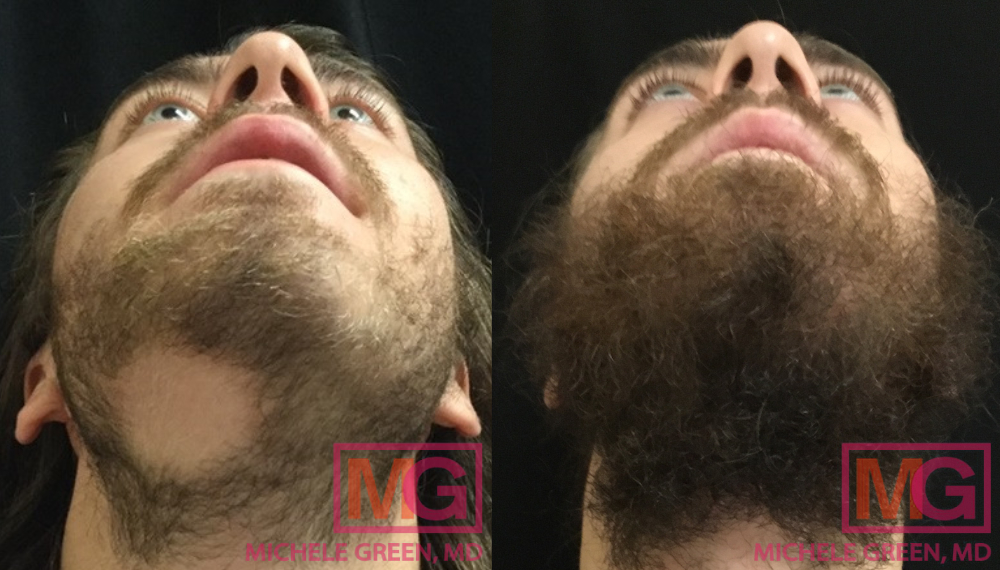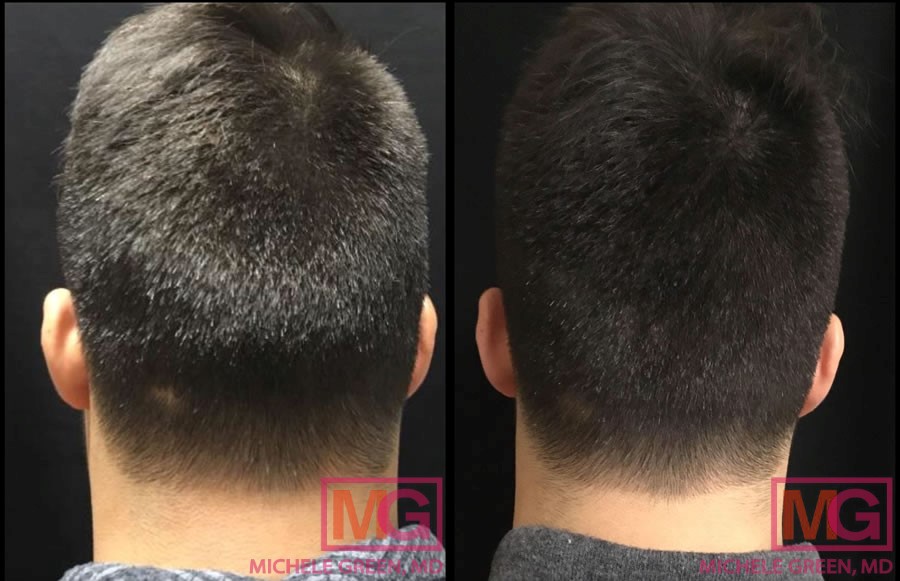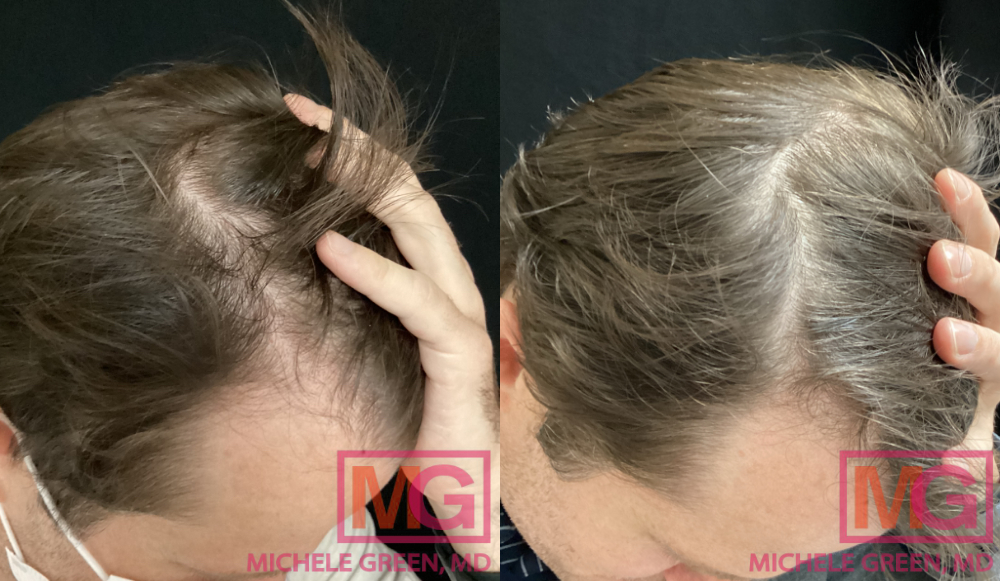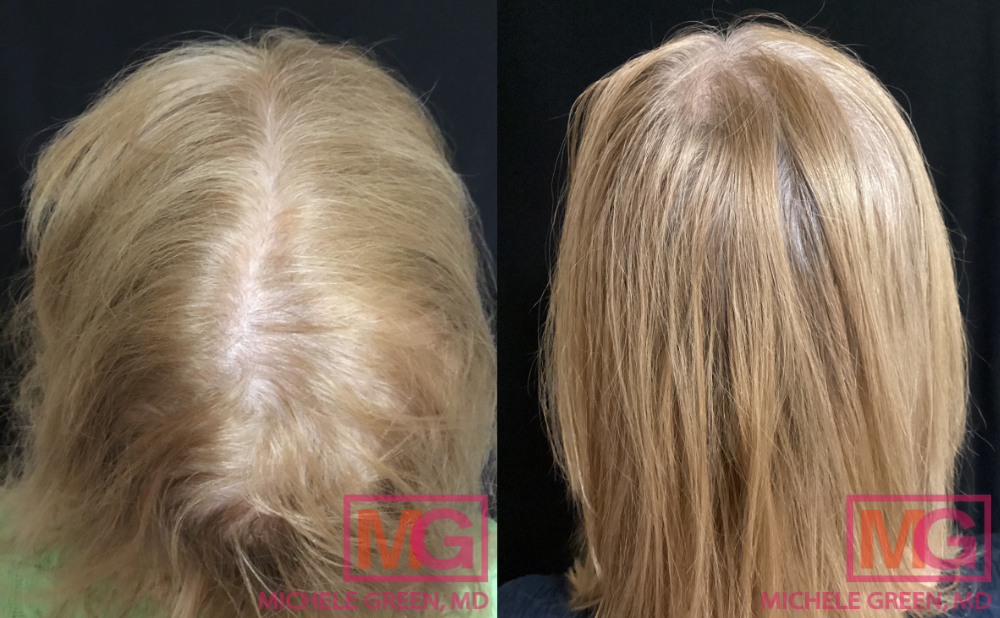Can Dermatologists Help With Hair Loss?
According to the American Academy of Dermatology, more than 80 million Americans experience hair loss or thinning. While hair shedding, hair thinning, and a receding hairline are common conditions, many patients still find hair loss distressing, leading them to wonder: How do I stop hair loss from occurring? The most important first step for developing an effective treatment plan for hair loss is to diagnose the root causes of hair loss. Most commonly, patients may experience hair loss due to genetic conditions, such as androgenetic alopecia (male pattern hair loss and female pattern hair loss) or alopecia areata, stress-related conditions, such as telogen effluvium, malnutrition or anorexia, medications, fungal infection, bacterial infection, hairstyles (traction alopecia), Polycystic Ovary Disease, vitamin deficiencies, Trichotillomania, or hormone imbalance due to puberty, pregnancy, or menopause. Without knowing the root cause of the hair loss that is occurring, it is impossible to prescribe the right medication, supplement, or treatment option, which is why the best first step for hair loss treatment is to schedule a consultation appointment with expert board-certified dermatologist Dr. Michele Green.
Dr. Green offers many treatment options at her New York City dermatology office, depending on the type of hair loss you are experiencing. First, Dr. Green will perform a complete examination of the hair and skin, blood tests, and a scalp biopsy to determine the cause of the hair loss and develop an individualized treatment plan to fit your needs. For some patients, the ideal treatment option may be a topical treatment, such as Rogaine (topical Minoxidil) or Spironolactone. Oral medications, such as finasteride, can be prescribed by a dermatologist in combination with topical treatments. Topical and oral medications can also be combined with in-office treatments, such as platelet-rich plasma injections (PRP), to strengthen the hair follicles, increase blood flow, and promote new hair growth. Dr. Green can also recommend the best hair products, such as shampoos and conditioners, that will protect from additional hair shedding or hair thinning. To get started on your path to hair care and hair regrowth, schedule your initial consultation with Dr. Michele Green.
Experienced board-certified dermatologist Dr. Michele Green has been expertly treating patients at her Upper East Side New York City dermatology office for more than 25 years. Well-versed in addressing a wide range of cosmetic concerns and medical conditions, Dr. Green is a master at identifying the root cause of hair loss to create an individualized treatment plan that will slow hair shedding and strengthen hair follicles for thicker hair regrowth. In addition to hair loss treatment, Dr. Green is an expert in cosmetic treatments such as Botox, dermal fillers, laser therapy, microneedling, chemical peels, platelet-rich plasma injections, and more. Well-known for high patient satisfaction, Dr. Green has been voted one of the best dermatologists in New York City by such publications as Castle Connolly, Super Doctors, and New York Magazine.

What are the different types of hair loss?
The most important step in beginning hair loss treatment is receiving an accurate diagnosis of the root cause of the hair loss. Hair shedding and thinning can occur due to genetic predisposition, stress, auto-immune system disorders, thyroid problems, cancer treatment, hormonal changes, or as a side effect of some medications. Below are some of the most common conditions that lead to bald spots, hair loss, or rapid hair shedding:
Androgenetic Alopecia
Androgenetic alopecia, also known as female or male pattern baldness, is a hair loss condition associated with elevated levels of the androgen hormones, which bind to the hair follicles and damage them. In men, male pattern hair loss typically begins with hair thinning at the temples, resulting in a receding hairline that creates the characteristic “M” shape. Hair loss continues on the crown of the head and can continue to worsen over time. In women, thinning hair typically begins along the top of the head, causing the part of the hair to widen. The condition can begin affecting both men and women in their 20s and 30s and can become more prominent with age. The risk factors for developing androgenetic alopecia are yet unknown, though researchers believe that there is a strong genetic component.
Alopecia Areata
Alopecia areata is an autoimmune condition that occurs when white blood cells damage the hair follicle, causing new hair growth to slow and the follicle to shrink. Characterized by bald patches that appear most commonly on the head (though the condition can develop anywhere on the body), alopecia areata can occur suddenly — though it is not associated with stress-related situations. Researchers believe that the condition is genetic, and while some patients can experience alopecia areata followed by full hair regrowth, for some, hair loss may be permanent. For the most part, patients with alopecia areata experience small patches of hair loss the size of a quarter. However, for others, the extent of hair loss may be more extreme. Alopecia areata can affect patients of any age and gender and frequently comes on quickly — within the span of a few days.
Telogen Effluvium
Telogen effluvium is a hair loss condition caused by extreme stress or shock, which triggers hair to enter the resting phase of hair growth (known as the telogen phase) prematurely. As a result, a large number of hairs enter the shedding phase at the same time — sometimes, as many as 70% of the hairs on the scalp can be shed at once, leading to noticeable hair thinning and shedding. Stressful events that can trigger telogen effluvium include:
- Severe illness, such as chronic illness or high fever
- Childbirth
- Overactive thyroid
- Severe infections
- Severe psychological distress
- Major surgery or injury
- Losing weight quickly, such as crash diets or anorexia
- Some medications
Typically, hair regrows in three to six months once the stressful event has been resolved, but seeking treatment from a dermatologist can help speed up the regrowth process and ensure the overall sound health of the hair follicles.
What are the best hair loss treatment options?
The best hair loss treatment option depends on the root cause of the hair loss. Many patients experiencing hair loss will turn to companies like “Hims,” which offers hair loss solutions without doing any testing beforehand. Some treatment options are ineffective for certain types of hair loss and can actually worsen hair shedding. That is why it is essential to start your hair loss treatment by visiting an experienced board-certified dermatologist, who will identify the root cause of your hair loss with a range of tests to recommend the best treatment option for you. Depending on the type of hair loss patients are experiencing, Dr. Green may turn to topical medications, such as minoxidil or spironolactone, oral medications, such as finasteride, injectable steroids, such as corticosteroids, platelet-rich plasma injections, low-level laser therapy, or, in extreme cases, hair transplant or hair graft.

How can a dermatologist help with hair loss?
Dermatologists are generally experienced in treating hair loss conditions. In addition to treating skin conditions such as acne breakouts, acne scars, hyperpigmentation, fine lines, wrinkles, facial volume loss, and uneven skin texture, dermatologists can be highly skilled in diagnosing hair loss conditions and prescribing the medication or treatment options that will best combat symptoms of hair shedding. Dr. Green, in particular, is well-known for the care she takes when diagnosing patients and developing individualized treatment plans to promote hair regrowth, thicken and strengthen the hair follicle, and prevent or slow future hair shedding.
Will a dermatologist help with hair loss?
Many patients wonder, “Do dermatologists treat hair loss?” and the answer is yes! Hair loss is a regular part of the hair growth cycle, with most people losing an average of 50-100 hairs per day. At any one time, the majority of the hair on one’s head is in the growth phase, where hair will stay for between two and five years. Following the growth phase, the hair enters a resting phase (known as the telogen phase) and then falls out. If you notice that you are losing more than 150 hairs a day or are experiencing thinning along the temple and scalp, schedule an appointment with a dermatologist today.
How do dermatologists treat hair loss?
The first step to treating hair loss is to schedule a consultation appointment with a dermatologist, such as board-certified dermatologist Dr. Michele Green. Dr. Green will ask you to disclose your medical history and then run tests to diagnose the type of hair loss occurring. Once the cause of hair loss is determined, Dr. Green will generate an individualized treatment plan to strengthen the hair follicles, promote hair regrowth, and slow the loss of hair. It is essential to seek treatment from a dermatologist as the acquisition of over-the-counter medications without consulting an expert can result in a worsening of the condition.
Can a dermatologist diagnose hair loss?
One of the major benefits of seeking treatment from an expert dermatologist for hair loss conditions is that the dermatologist can accurately diagnose the root cause of the hair loss. During your initial consultation, Dr. Green will begin by asking you about your overall health and medical history, including any medications you are taking, medical conditions, surgeries, and recent travel. Next, Dr. Green will conduct a thorough examination of the skin, hair, scalp, and nails to try to determine the cause of hair loss on the scalp. In some cases, Dr. Green will request a complete panel of blood work to determine if hormonal changes, thyroid problems, or other autoimmune disorders cause hair loss. Additionally, a fungus culture or biopsy may be requested for thorough testing.
What can a dermatologist prescribe for hair loss?
The medication that Dr. Green prescribes to address hair loss depends on the condition that is being addressed. For androgenetic alopecia, Dr. Green may prescribe topical minoxidil, which is FDA-approved to address the condition. By increasing blood flow to the scalp and helping to move dormant hairs into the growth phase, topical minoxidil helps to promote new hair growth. Topical minoxidil can be applied to the scalp via a dropper or as a foam. In some cases, Dr. Green may prescribe oral minoxidil, which was originally used to treat high blood pressure. Another oral medication that Dr. Green often turns to is finasteride, sometimes also known by the brand name Propecia, which is a DHT blocker that works to prevent future hair loss from occurring. Patients experiencing female pattern hair loss or PCOS may be prescribed spironolactone, which, like finasteride, blocks the production of DHT, helping to prevent future hair loss.

Can a dermatologist help with thinning hair?
Many patients wonder, “Do dermatologists treat thinning hair?” and the answer is yes! One of the common causes of thinning hair is male pattern hair loss, which is a genetic condition characterized by a receding hairline and loss of hair along the temples and crown of the head. When treating male pattern hair loss, Dr. Green will often turn to a combination approach of topical minoxidil and oral finasteride. Topical minoxidil, which is sometimes known by the brand name Rogaine, is a vasodilator, which means that it increases blood flow at the treatment area, which causes more oxygen to be delivered to the hair follicles, promoting new hair growth. Minoxidil is also effective at activating dormant hairs, sending them into the growing phase, which helps to create a thicker look to the hair. Oral finasteride is a DHT blocker that can also be used to address thinning hair by blocking the action of the enzyme that turns testosterone into DHT, which can damage hair follicles. For some patients, Dr. Green may also turn to PRP injections, which improve blood supply to the hair follicle, helping to repair the follicle and promote new hair growth.
Can a dermatologist help with female hair loss?
Female hair loss is a common condition, with as many as 55% of all women experiencing some form of hair loss by the time they are fifty years old. There are many risk factors for developing hair loss as a woman, including female pattern hair loss (androgenetic alopecia), hormone fluctuations due to puberty, pregnancy, or menopause, medications, injury or illness, and severe stress. Many women who become pregnant experience post-partum hair loss, which is hair shedding that occurs in the months after giving birth. This is caused by the many hairs that enter the resting phase during pregnancy shedding at once. A dermatologist can certainly be helpful in diagnosing the type of hair loss that women are experiencing and developing a treatment plan.
Can a dermatologist help with alopecia?
Androgenetic alopecia is a common hair loss condition that can affect both men and women and is frequently referred to as “hormone-related baldness.” Androgens are a type of hormone that is converted into dihydrotestosterone (DHT), a hormone that can bind to hair follicles and damage them. The treatment for androgenetic alopecia typically involves a DHT blocker, which blocks the action of the 5-alpha-reductase enzyme that is responsible for converting testosterone into DHT. Dr. Green will often prescribe finasteride or spironolactone, which are two DHT blockers that slow the production of DHT and protect the hair follicles from additional damage.
Can a dermatologist cure hair loss?
Whether or not hair loss can be “cured” depends on the type of hair loss that the patient is experiencing. Hair loss that occurs due to a medication or an acute incident or stress, such as telogen effluvium, post-partum hair loss, or cancer radiation therapy, can typically be completely reversed, and dermatologists can prescribe medication or in-office therapies to promote hair regrowth and healthy hair follicles. Some types of hair loss, however, cannot be completely reversed. The symptoms of androgenetic alopecia can typically be mitigated with the help of a dermatologist, but hair loss does not typically go away completely. Similarly, hair loss that occurs due to scarring will typically not grow back on its own, leading patients to turn to surgical procedures such as hair transplants or hair grafts.
What can dermatologists do for hair loss?
Many treatment options can be prescribed by a dermatologist to address hair loss, hair thinning, or hair shedding due to a variety of causes, including androgenetic alopecia, telogen effluvium, alopecia areata, medication, vitamin deficiency, malnutrition, and more. Dermatologists will begin by examining the treatment area and running blood tests to determine the root cause of the hair loss. Then, a dermatologist can generate a treatment plan that will address the cause of hair loss, which can include topical medication, oral medication, PRP injections, laser therapy, prescribed hair vitamins, or corticosteroid injections.
Can a dermatologist help with hair growth?
A dermatologist can definitely help with hair regrowth. In fact, it is best to seek out a board-certified dermatologist to generate a treatment plan rather than purchasing over-the-counter medications that may prove ineffective or even harmful. One of the most effective treatments for promoting new hair growth is platelet-rich plasma (PRP) injections. The PRP treatment process begins with drawing the patient’s blood and placing it in a centrifuge to separate the red blood cells from the platelet-rich plasma. The PRP, which is rich in growth factors, is then injected into the scalp to improve blood circulation, promote tissue healing and regeneration, improve hair thickness, and extend the growth phase of the hair follicles. PRP injections are not associated with any downtime or significant side effects.

Do all dermatologists treat hair loss?
Many patients wonder, “Do dermatologists treat hair problems?” and the answer is yes — many dermatologists are trained to treat hair loss in addition to other skin conditions. However, it is essential to seek treatment from a board-certified dermatologist who is an expert in hair loss condition diagnosis and treatment, such as Dr. Michele Green. When you schedule your first consultation with Dr. Green, she will examine the treatment area and run any necessary blood tests to diagnose the cause of hair loss to generate a treatment plan that will best meet your needs.
How do I get started with hair loss treatment today?
Hair loss is extremely common, affecting as many as 80 million Americans. But even so, hair loss can be very distressing, causing patients to feel increased anxiety or lower self-esteem, leading many to seek a solution. With many hair loss treatments available over-the-counter or advertised by companies like “hims,” it can be difficult to know which hair loss treatment option is the safest and most effective. Additionally, using the wrong product can worsen hair loss and damage to the hair follicles. That is why it is essential to seek treatment from an expert board-certified dermatologist, such as Dr. Michele Green, who has been treating patients in her New York City dermatology office for more than 25 years. Dr. Green makes a full examination of the skin, scalp, hair, and nails to determine the root cause of hair loss and provide the treatment plan that will best meet patients’ needs.
Dr. Michele Green is an internationally renowned board-certified dermatologist with over two and a half decades of experience providing her patients with the best non-invasive treatment options. Dr. Green takes a holistic approach and embraces a less-is-more philosophy, creating customized skincare routines and treatment plans that cater to the unique concerns and aesthetic goals of her patients. She is consistently identified as one of New York’s best dermatologists by Castle Connolly, New York Magazine, and Super Doctors for her dedication to her patients and expertise. Please call us at 212-535-3088 or email our New York City-based office today to schedule a consultation with Dr. Michele Green and get started on addressing your hair loss today.
 212-535-3088
212-535-3088